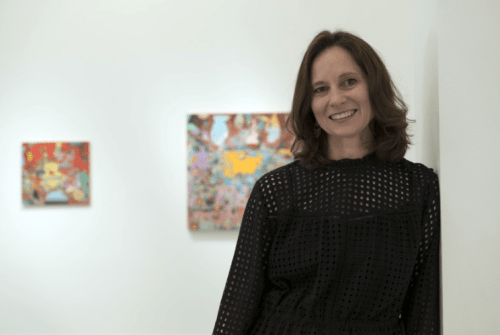
When artist Carolyn Case starts a painting, she’s never sure how it will end up.
Her vibrantly colored abstract oils are multilayered, multitextured studies that seem take on a life of their own.
“I try to give over to them 100 percent,” said Case, who is currently working on a few paintings during a residency at the Lux Art Institute in Encinitas.
During her four-week stay, which ends July 13, she is creating a series of three or four paintings based on a large, overgrown prickly pear cactus on the Lux property.
“The center looks like death. It becomes an enigmatic space,” Case said of the gnarled old plant whose interior has died off but continues to grow outward with fresh pads.
Each morning, she goes out and makes fresh sketches of the cactus and then uses those as inspirations for quick pastel drawings that study color values and shading. The pastels are then translated into the oil paintings.
The paintings start with a wood panel. The bottom layer is loose depiction of the cactus in a thin oil base. Case then adds layers and texture with oils in different thicknesses and a variety of techniques from broad brush strokes to small dots or even drips. Often sections are sanded down and reworked.
“It’s starting to morph,” Case said of the fledgling pieces, which she works on simultaneously.
The residency allows Case to spend full days on her work, but it also condenses the time frame to get the paintings done.
“Normally, I really dabble when I work and see where it takes me. There’s a lot of experimentation,” she said. “I have to alter how I normally work and take a single focus. It’s really eye opening to focus this much. It’s a really productive time frame.”
Case is a faculty member at Maryland Institute College of Art in Baltimore, where she lives with her husband and two teenage sons. She earned her bachelor of fine arts degree from California State University-Long Beach and a master of fine arts from the Maryland Institute College of Art’s Mount Royal School of Art.
“I was trained super formally,” she said. But over the years, she said, she shed perceptions and techniques that she no longer wanted to do. “I’m interested how small moments can mark larger time.”
Growing up, Case said, she was always creative but drawing and painting wasn’t on her radar. She wanted to be a graphic designer, but after a mandatory undergraduate drawing and painting class, Case said, “it all made sense to me.”
Along with residency, the Lux is exhibiting 18 of Case’s paintings, mostly dating from the past two years. Her works are explorations of how to mark time and experiences, each layered with texture and color to convey a feeling. Like the moments in life she starts with, the paintings often go in unexpected directions and combine chaos and order.
“I’ve moved from having more detailed moments to having larger movements,” she said of her paintings. The process is a journey to a feeling. “I might arrive at something different than what I thought.”
“Homemade Tattoo,” from 2017, started with a bird’s-eye view of a kitchen tabletop. The finished painting embodies not only what is physically on a kitchen table, but also the narrative and action that takes place at the table. The painting took Case more than two years to complete, working through the concept.
“I need time to explore. I have to experiment a lot to find the right solutions. I have to err a lot,” Case said. Other paintings were inspired by kitchen utensils, a landscape or the light in the water while swimming in the ocean. Shapes of vases appear in a number of Case’s paintings. The idea for the vases came from a trip to her husband’s homeland of Iran. There, she saw a wall with cutout forms of vases. The vases were gone, but the silhouettes remained.
“It seemed like the perfect metaphor for painting something to mark time,” she said.
Case spends a lot of time teaching and practicing color. During a residency in India 20 years ago, another artist noted that her colors seemed very “British.” That statement made her realize that color is connected to culture and class — and that she was using “Williams and Sonoma” colors. After that, her colors became very exuberant, she said. From there, they went to scratchy and messy and now they are a combination of all three.
“I layer. I sand. I do whatever it takes,” Case said.
The cactus pieces will undergo numerous transformations until the right combination of patterns, shapes, color and texture comes together to create the mood Case is looking for. She wants to convey the feeling she has standing in front of the ancient-looking plant with its cavernous, decaying skeleton-like center.
“I’m not sure where it’s going to end up,” she said.
Carolyn Case
When: In residence through July 13. On exhibit through Aug. 3.
Where: Lux Art Institute, 1550 S. El Camino Real, Encinitas
Tickets: Free, but donations accepted.
Phone: (760) 436-6611
Online: luxartinstitute.org
Schimitschek is a freelance writer.